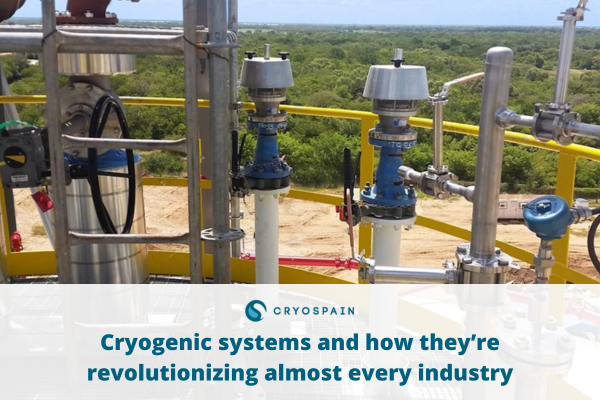Cryogenic systems are infrastructures designed to maintain extremely low (cryogenic) temperatures to preserve liquefied gases and other substances.
These systems include components such as cryogenic pumps, cryogenic storage systems, cryogenic piping, cryogenic chillers, and cryogenic dewars.
The growing market for cryogenic systems
The increasing demand for cryogenic systems responds to a growing use of these technologies across multiple industries.
According to PR Newswire, the cryogenic systems market is expected to grow at around 6.4% CAGR between 2020 and 2025, reaching USD 31.68 billion by 2026.
Why cryogenic gases are in high demand
The use of technical gases has expanded rapidly in recent years. These gases support industrial operations and offer more sustainable alternatives to traditional processes.
Common gases used in cryogenic applications include:
- Acetylene
- Argon
- Carbon dioxide
- Industrial oxygen
- Nitrogen
- Hydrogen
When liquefied, these gases are easier and more efficient to store and transport, requiring less space. This efficiency has driven the growing need for cryogenic systems capable of sustaining and preserving these elements.
You may like: Cryogenic plants: how we design and create tailor-made units for our clients
Key industries using cryogenic systems
Cryogenic technologies are transforming several industrial sectors. Let’s explore some of the leading industries applying cryogenic systems today.
Medical and pharmaceutical industry
Liquid oxygen systems are essential in medical and pharmaceutical applications.
Oxygen acts as a respiratory aid, while liquid nitrogen ensures rapid cooling for the storage and transport of cells and tissues.
Cryosurgery, which uses liquefied nitrogen, is increasingly applied to eliminate unwanted tissues or tumors, both benign and malignant.
Main gases used in the medical sector:
- Medical oxygen
- Medical air
- Carbon dioxide
- Nitrogen
- Nitrous oxide
- Helium gas
Keep reading: Designing a medical oxygen plant: everything you need to know
Transportation and space industry
The aeronautics and space sectors rely heavily on cryogenic systems to store liquid hydrogen, a growing fuel alternative for rockets and other aerospace vehicles.
In the automotive industry, cryogenic storage systems are becoming increasingly relevant. Hydrogen is emerging as a clean alternative to fossil fuels, while nitrogen assists in gas-assisted injection molding during component manufacturing.
Food industry
The food sector is progressively adopting cryogenics for freezing and cooling processes.
For example, liquid nitrogen is used to maintain optimal temperatures during transport and storage, ensuring cold-chain integrity and reducing losses.
Nitrogen also prevents oxidation in foods and enables innovations like modified atmosphere packaging (MAP).
Related content: What are food gases and which are the main ones?
Chemical industry
Cryogenic systems are crucial in the chemical and petrochemical industries.
Nitrogen acts as a transporting gas and liquefying agent in many processes and is used to create inert atmospheres that protect both products and facilities.
In oil refineries, nitrogen helps remove oxygen and humidity from tanks and pipes, enhancing safety and efficiency.
Electronics industry
The electronics sector benefits from cryogenics in semiconductor production and welding.
Nitrogen prevents oxidation and impurities, while cryogenic treatment increases the lifespan of circuit boards and other components.
Cryogenic environments are also vital in superconducting devices, reducing resistance and heat-related damage.
Metallurgy
In metallurgical applications, cryogenic systems enable the storage and transport of gases used in thermal treatments and laser cutting.
Liquefied natural gas (LNG) also plays a significant role in supporting advanced metallurgical processes.
Main components of a cryogenic system
A complete cryogenic system typically includes:
- Cryogenic piping: transports liquefied substances safely.
- Cryogenic pump: drives cryogenic fluids through the system.
- Cryogenic chiller: provides precise cooling to maintain low temperatures.
- Cryogenic dewar: acts as an insulated container for storage.
Each system can be customized to meet the unique needs of different industries.

Cryospain: engineering advanced cryogenic solutions
At Cryospain, we design and manufacture custom cryogenic equipment, managing the entire process from design to delivery of turnkey projects.
Our main cryogenic solutions include:
- Flat-bottom cryogenic tanks for storing liquefied gases such as LOX and LIN safely and efficiently.
- CRYOLINE piping systems, featuring high-vacuum insulation and customized design using 3D software and finite element verification.
- Filling stations for CO₂ and N₂O, including high-pressure systems.
- Satellite LNG regasification plants.
- LNG and LCNG fueling stations.
- Train transformations to LNG.
- Trolleys and bottle filling ramps.
Our team provides mechanical and thermal design, manufacture, and commissioning of high-tech cryogenic systems.
Learn more about cryogenic systems
Cryogenic systems are revolutionizing industrial processes by enabling efficiency, sustainability, and innovation across sectors.
Want to learn more about how cryogenic technology can transform your operations? Get in touch with Cryospain’s team of experts.











 Contacte-nos
Contacte-nos